Spice Trade Chronicles 10 India, the Finale
India’s climate shaped the destiny of the spice route.
With different climates in every corner of the country, India is able to produce a variety of spices. Most spices were native to India, but throughout the course of history, many spices have been imported, and now grow abundantly.
The Malabar Coast, probably one of the most famous tourist destinations in India, spans the entire coastline of Kerala on the west coast of India.  This is the area where boats would make pit stops on their way to and from their own countries along the spice route.
This is the area where boats would make pit stops on their way to and from their own countries along the spice route. 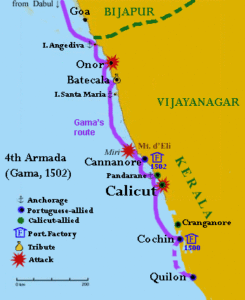 These ports of call along the Malabar coast became intermediary points for trade between East and South East Asia with the European and Arabian worlds. It’s interesting that the ports were not directly on the coast, but a little bit inland along the waterways, probably to seek safe anchorage during the trading transactions. Most of these ancient ports of call are now buried cities, but remain areas of interest for archaeologists. There are many ports along the edge of the Red Sea and Africa where archaeologists are also busy at work learning about our past. Spice trading became an industry, generating income and wealth.
These ports of call along the Malabar coast became intermediary points for trade between East and South East Asia with the European and Arabian worlds. It’s interesting that the ports were not directly on the coast, but a little bit inland along the waterways, probably to seek safe anchorage during the trading transactions. Most of these ancient ports of call are now buried cities, but remain areas of interest for archaeologists. There are many ports along the edge of the Red Sea and Africa where archaeologists are also busy at work learning about our past. Spice trading became an industry, generating income and wealth.
The discoveries of spices brought together three continents, Europe, Asia and Africa. Coming later, would be the Caribbean, and North and South America. More on this later!
We use spices everyday, and fail to think about how these little guys changed the course of history!
Thanks to the discovery of the delightful attributes of spices, countries flourished, and people became wealthy.
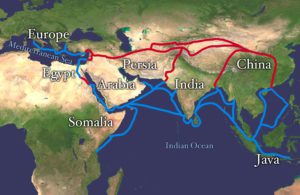 Black pepper was the most popular spice which, at some points in history, was more valuable than gold. Because of this it was nicknamed, black gold! Everyone wanted to own the spice islands. Portugal, The Netherlands, England, Egypt, Arabia, Ethiopia, Italy, all took turns trying to monopolize the spice trade for themselves.
Black pepper was the most popular spice which, at some points in history, was more valuable than gold. Because of this it was nicknamed, black gold! Everyone wanted to own the spice islands. Portugal, The Netherlands, England, Egypt, Arabia, Ethiopia, Italy, all took turns trying to monopolize the spice trade for themselves.
This led to many wars though out the land, not just for spices, but religions came into force also. The strife between Muslims and Christians curtailed the trade, sealing off the caravan routes across land and eventually almost stopped trade to Europe. Once the maritime trade route discovered by the Portuguese became known, more ports were created along the shores of the spice islands and the trade expanded even more.
The Portuguese were the first to try to monopolize the trade of pepper with their new maritime routes. They wanted the “black gold” all to themselves. They thought their new routes would allow them the sole ownership of the pepper trade, but that didn’t happen.
People went crazy for pepper!
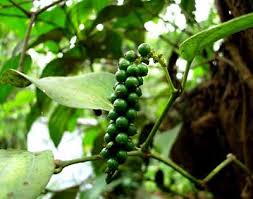
It was used for dowries, most famously, the marriage of Dona Isabella of Portugal and Charles V of Spain. It was used in the burial chambers of Egypt in the Pharaonic age. Evidence of pepper was found in the funerary monument of Queen Hatshepsut on the west bank of the Nile river. Pepper was used in the mummification of Ramses the Great. So you can see, the little seed of pepper was actually a giant as it was worth so much that it was used as currency instead of a commodity.
Of course, because pepper was grown in India, India prospered through out this pepper craze. Gold was used to pay for the pepper! Pepper was used in England as payment from Germany to do business in London. Portugal acquired 2 million kilograms of pepper annually from the Malabar coast. That’s a lot of pepper!
As different cultures were discovered people began to realize how diverse our world really is.
By now we’ve seen that the spice merchants were probably about the wealthiest people in ancient times. But with wealth comes many other problems. The discovery of the value of spices set a precedent for greed, war, mysticism, legends, but most importantly, flavor!
The most lucrative of the spice traders during this time were the Arabians.
One reason they were so successful was because they hid the sources of the spices that they had for sale. They made up legends of mystical creatures to scare people away. Back then people believed in omens, magic, charms and other mythical ideas, so telling tales of winged creatures and insects who watched over the spices were totally believable by many. The tall tales didn’t just protect their sources for the spices, this was also a way to increase the prices. 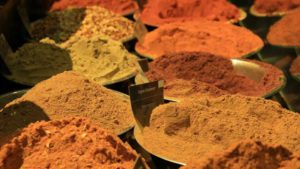 Cinnamon, cassia, cardamom, ginger, and turmeric were some of the most important spices and brought the highest prices at the markets.
Cinnamon, cassia, cardamom, ginger, and turmeric were some of the most important spices and brought the highest prices at the markets.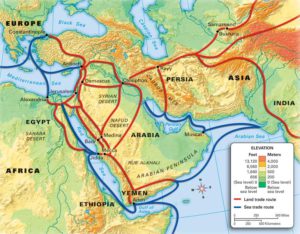
Overland routes. the most popular, otherwise known as the Old Silk Road, were the main routes taken at first, but merchant vessels traveling over water became more popular as time went on. They were safer, faster and ships could carry more cargo than wagons. The land routes were hazardous as it was easy for outlaws to lay in wait, and hold up the caravans to steal the cargo.
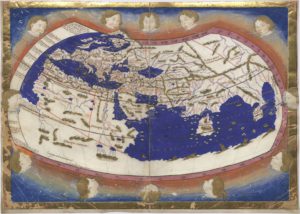
Vasco Da Gama discovered the alternate maritime route to India, this changed everything. It was safer than the land routes, yet they still held their own danger. Weather played a huge role in when they would set sail, and then pirates played a huge factor on their safety.
The Portuguese tried to hold on to their newly found, profitable trade, but only to be overtaken by the Dutch in the 1590’s. The Dutch were smart and had greater navigational skills, thus were able to find shorter, safer routes to India. War broke out between the two in 1602, known as the Dutch-Portuguese War. This was an extension of the Eighty years War. Ultimately, the Dutch took over the East Indies, consisting of India and the islands surrounding it.
Eventually England was able to gain the power away from the Dutch with the inauguration of the British East India Company. England and Holland started to fight for the spice rights, and the Dutch lost their hold over the Indian spice trade. By the 1800’s, England controlled the trade. You can see how this went back and forth for quite a while! But eventually, the uniqueness was lost.
Nowadays spices are sold world wide.
It’s pretty easy to get any spice you like online with so many wholesalers and retailers available. Today, the spice trade has certainly changed, now it’s just up to the farmers and the importers getting the spices through customs! In the United States, large companies like McCormick take care of all that hard stuff for us.
So what are Indian spices?
India produces 75 varieties of spices of the 109 listed by the International Organization for Standardization (ISO), and is also the world’s largest producer of spices. India produces about 2.5 million tons of spices per year.
The most endogenous spices used regularly in Indian cuisine are Green and Black Cardamom, Fennel Seed, Asafoetida, Ajwain Seeds, White and Black Pepper, Cumin, Bay Leaf, Cinnamon, Cloves, Coriander, Fenugreek, Curry Leaf, Garlic, Ginger, Mint, Mustard Seed, Nigella Seed, Nutmeg, Mace, Amchoor (Mango Powder), Saffron, Tamarind, Turmeric, Basil, Chiles. Kashmiri chiles are an ingredient in a couple of my spice mixes, they are really hard to find in the US, so a good substitute is a 3:1 ratio of paprika to cayenne pepper if you can’t find any.
This is quite a list, and you’ll think you could never own all of these spices to make your own Indian food, but if you just start collecting them for various recipes, before you know it, you’ve got an entire collection! Just like collecting pennies, they add up over time.
Gather your spices, make delicious mixtures!
When you have your Indian spice collection, you can make a number of Indian Spice Blends such as Garam Masala, Chaat Masala, Madras Curry Powder, Tandoor Masala, and Panch Phoran. These mixtures can be broken down into many other ethnic variations from different parts of the country. I have compiled a list of Indian spice blend recipes should you like to venture forth and make your own.
Curry refers to the name of a dish, but Masala refers to a mixture of spices.
There are as many curry powders as their are countries where they came from and that can be broken down to districts and towns! Each Grandma has her own recipe, and hopefully, if you have an Indian Grandma, she handed her spice recipes down to you. There are also pastes which are used in many dishes and are kept on hand in the fridge. These include Garlic-Ginger Paste, and Vindaloo Paste, just to name a couple.
Some of the more unfamiliar spices you may not have heard of include:

Curry Leaf is actually a whole leaf from a tree native to India, which lends it’s own character and flavor to a dish. There’s really no substitute for it. It doesn’t dry well so it’s really only useful fresh. I keep some leaves in my freezer.
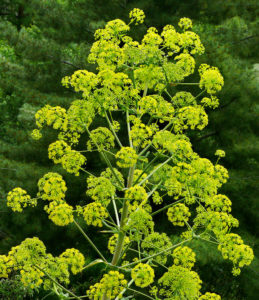
Asafoetida, otherwise known as hing, is a spice which is actually derived from an herb plant. It is commonly known as food of the Gods. Particularly used in vegetarian Punjabi cuisine, along with turmeric, it is commonly used to flavor lentil or chickpea curries. It goes without saying that they probably use it in bean dishes because it helps to reduce flatulence! Asafoetida has wheat flour added to it to help with emulsification so it is not gluten free is gluten is a problem for you.
Amchoor is a fruity, spicy powder made from unripe mangos. This is a Very Indian spice, I say this because I don’t think it’s found in any other cuisine. It lends a fruity, citrusy note to dishes.
Ajwain, (pronounced aj’o-wen) is a member of the Umbelliferae family, which include dill, caraway and cumin. It is mostly found in Indian cooking, and is also known as bishop’s weed or carom. When the seeds are crushed, they have a strong fragrance similar to thyme.
Then you mix all the spices up and get the infamous Indian spice blends:

Garam Masala gets it’s name from it’s components. Garam means “hot” and Masala means “mixture of spices”. this mix is often used alone at the end of the cooking time, or mixed with other spices to create other flavorings. An easy Chaat Masala can be made by combining Garam Masala with ginger, cumin, amchoor, and hing.
Madras Curry Powder is similar to Garam, yet is much hotter because it has a larger quantity of paprika and chile powder, adds a brighter red color to dishes.
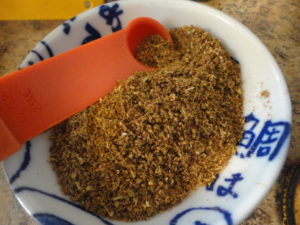
Chaat Masala is popular in street food as vendors will sprinkle this sweet, tangy, hot spice on fresh fruits and vegetables making a refreshing snack in the heat of India. Similar to Garam Masala, the addition of citrusy Amchoor sets this one apart from all others.
Panch Phoran is one of my favorite spice blends. Unlike the previous masalas, Panch Phoran is used as a whole spice mixture in curries and dals. It is made with whole seeds and is delicious in curries made with vegetables such as cauliflower and potatoes.
Indian cuisine is so much fun to eat and serve.
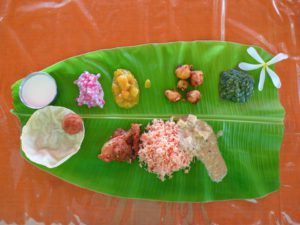
Have your friends over and entice their taste buds with an Indian meal. You can make your get together seem like a trip to India.
Use banana leaves in place of plates and to serve the meal.  They are a really easy way to create an exotic atmosphere. Banana leaves can be found in the produce or frozen section at your grocery store. You can wrap stuffed rice in the leaves with a curry filling, and steam them.
They are a really easy way to create an exotic atmosphere. Banana leaves can be found in the produce or frozen section at your grocery store. You can wrap stuffed rice in the leaves with a curry filling, and steam them.
Also fun to do is to make your own Indian Paneer, and breads.
Paneer is so simple to make, just milk and lemon juice. Breads come in many different options, Roti, Naan, Paratha, or Chapati. You can easily make Chapati with Paratha dough, just roll it and cook it on the griddle with no filling! Naan is traditionally baked in a Tandoor oven, you can use a pizza stone or a cast iron skillet and come out with really authentic results.
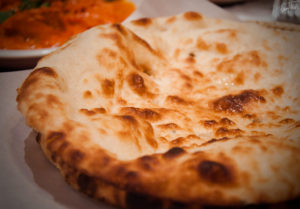
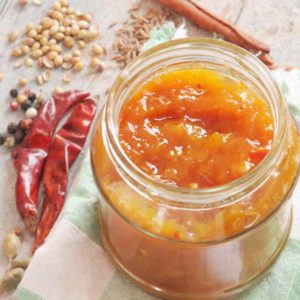
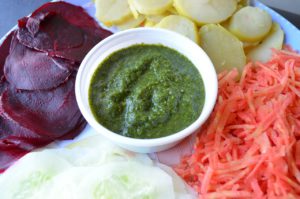
As with most Asian meals, pickles, chutneys and Raitas are served to both enhance the flavors of the dishes and to cool down the heat. They can be very simple, just yogurt with cucumber and/or mint, or they can be more complicated with many spices and herbs. I think plain yogurt does the trick too! Pickles and chutneys can range from scorching hot to mild. Chutneys are made with all different kinds of fruits. Mango Chutney is my favorite, and probably the most popular. Mint Chutney is great to dunk fritters into, and to flavor rice. Mix it with yogurt and make a dip for tandoori and kabobs.
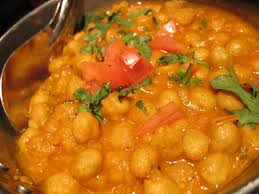 A really fun party idea would be to make Naan, chutney, paneer, some fresh fruits and vegetables, and put it out as an appetizer platter. You don’t see that every day! Try my Grilled Curry Garlic Chicken with Yogurt Sauce as your main course. Serve it alongside grilled Naan bread, which you can also make ahead of time and grill it along with the chicken. Include chutneys, make ahead, paneer, and rice wrapped in banana leaves. Your guests will be wowed! Include Red Lentil Curry also for dunking the Naan.
A really fun party idea would be to make Naan, chutney, paneer, some fresh fruits and vegetables, and put it out as an appetizer platter. You don’t see that every day! Try my Grilled Curry Garlic Chicken with Yogurt Sauce as your main course. Serve it alongside grilled Naan bread, which you can also make ahead of time and grill it along with the chicken. Include chutneys, make ahead, paneer, and rice wrapped in banana leaves. Your guests will be wowed! Include Red Lentil Curry also for dunking the Naan.
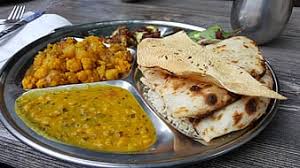
Of course, curries are all the rage in the restaurant scene today, and if you have a stocked spice cabinet, they really are only at your finger tips. I love Vindaloo, it’s spicy, sour and a bit sweet. Chana Masala, or curried chick peas is probably the most well known Indian curry, and is very easy to make. This could be your new “go to” meal for busy weeknights.
I love my kitchen gadgets, and is you own an Instant Pot, you can make curry and rice as well, all at once, and have dinner on the table in no time with very little fuss and clean up. All this is possible if you have pre-made spice mixes and a few pantry staples on hand.
I hope I’ve given you some insight in what our predecessors have gone through to bring us all these terrific flavors and recipes.
I have learned so much in researching these Chronicles and I have developed a great respect for our ancestors and what they went through to bring us these special, healthy foods. I’ve spend a lot of time in the kitchen trying new recipes too which is one of my favorite things to do! Some were good, some, I was not a fan of. I have definitely broadened my spice cabinet.
Ultimately, the war on spice wore off. I think everyone finally realized there was enough to go around! The Chinese had given up on the spice trade when De Gama started his tyranny against India. I guess they were just wise, and had better things to do! Ironically, even though humans tried to monopolize the spice world, and keep it in certain areas, nature took it’s course. Through the seed distribution between birds and other animals who ate the spices, the seeds were spread and trees were able to grow without any help from humans in many other countries.
The search for spices brought on the birth of the America’s. Columbus was looking for the riches associated with spices, but unfortunately, he never found his way to the spice islands, he ended up in the Caribbean.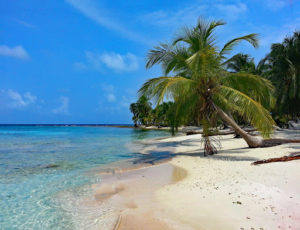
For this, our next trip and chapters of Spice Chronicles will be in the Caribbean. I love the islands in the Caribbean, they are hot, exotic, beautiful and full of intriguing people and folklore. So on our next journey, I will be embarking on a “ship” throughout the Atlantic Ocean and The Caribbean Sea to find out how all these beautiful spices came to be known throughout the world. I hope you’re as excited about this trip as I am. I will bring more legends, recipes and historical stories that you can share with friends and loved ones.
Thanks for reading, please leave me a comment if you have any ideas or if there is something you’d like to find out about. Sincerely, Jeanette

Thanks for sharing this wonderful information through this blog, along with want to know more information please visit.
Thank you, just trying to spread the word about how wonderful spices are!